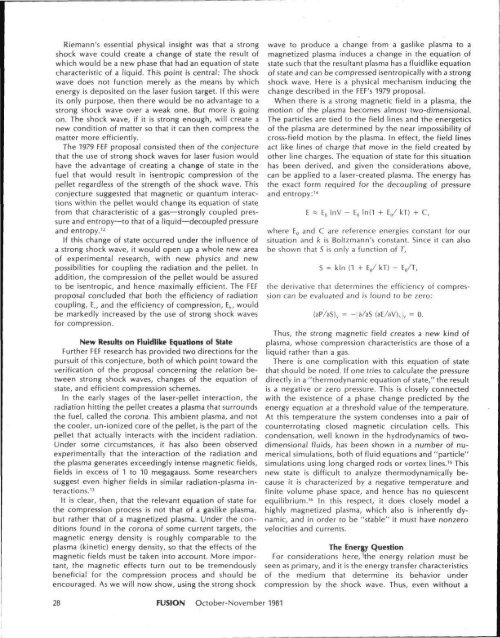Riemann's Contribution to Flight and Laser Fusion
Riemann's Contribution to Flight and Laser Fusion
Riemann's Contribution to Flight and Laser Fusion
- No tags were found...
Create successful ePaper yourself
Turn your PDF publications into a flip-book with our unique Google optimized e-Paper software.
<strong>Riemann's</strong> essential physical insight was that a strongshock wave could create a change of state the result ofwhich would be a new phase that had an equation of statecharacteristic of a liquid. This point is central: The shockwave does not function merely as the means by whichenergy is deposited on the laser fusion target. If this wereits only purpose, then there would be no advantage <strong>to</strong> astrong shock wave over a weak one. But more is goingon. The shock wave, if it is strong enough, will create anew condition of matter so that it can then compress thematter more efficiently.The 1979 FEF proposal consisted then of the conjecturethat the use of strong shock waves for laser fusion wouldhave the advantage of creating a change of state in thefuel that would result in isentropic compression of thepellet regardless of the strength of the shock wave. Thisconjecture suggested that magnetic or quantum interactionswithin the pellet would change its equation of statefrom that characteristic of a gas—strongly coupled pressure<strong>and</strong> entropy—<strong>to</strong> that of a liquid—decoupled pressure<strong>and</strong> entropy. 12If this change of state occurred under the influence ofa strong shock wave, it would open up a whole new areaof experimental research, with new physics <strong>and</strong> newpossibilities for coupling the radiation <strong>and</strong> the pellet. Inaddition, the compression of the pellet would be assured<strong>to</strong> be isentropic, <strong>and</strong> hence maximally efficient. The FEFproposal concluded that both the efficiency of radiationcoupling, E r , <strong>and</strong> the efficiency of compression, E h , wouldbe markedly increased by the use of strong shock wavesfor compression.New Results on Fluidlike Equations of StateFurther FEF research has provided two directions for thepursuit of this conjecture, both of which point <strong>to</strong>ward theverification of the proposal concerning the relation betweenstrong shock waves, changes of the equation ofstate, <strong>and</strong> efficient compression schemes.In the early stages of the laser-pellet interaction, theradiation hitting the pellet creates a plasma that surroundsthe fuel, called the corona. This ambient plasma, <strong>and</strong> notthe cooler, un-ionized core of the pellet, is the part of thepellet that actually interacts with the incident radiation.Under some circumstances, it has also been observedexperimentally that the interaction of the radiation <strong>and</strong>the plasma generates exceedingly intense magnetic fields,fields in excess of 1 <strong>to</strong> 10 megagauss. Some researcherssuggest even higher fields in similar radiation-plasma interactions.13It is clear, then, that the relevant equation of state forthe compression process is not that of a gaslike plasma,but rather that of a magnetized plasma. Under the conditionsfound in the corona of some current targets, themagnetic energy density is roughly comparable <strong>to</strong> theplasma (kinetic) energy density, so that the effects of themagnetic fields must be taken in<strong>to</strong> account. More important,the magnetic effects turn out <strong>to</strong> be tremendouslybeneficial for the compression process <strong>and</strong> should beencouraged. As we will now show, using the strong shock28 FUSION Oc<strong>to</strong>ber-November 1981wave <strong>to</strong> produce a change from a gaslike plasma <strong>to</strong> amagnetized plasma induces a change in the equation ofstate such that the resultant plasma has a fluidlike equationof state <strong>and</strong> can be compressed isentropically with a strongshock wave. Here is a physical mechanism inducing thechange described in the FEF's 1979 proposal.When there is a strong magnetic field in a plasma, themotion of the plasma becomes almost two-dimensional.The particles are tied <strong>to</strong> the field lines <strong>and</strong> the energeticsof the plasma are determined by the near impossibility ofcross-field motion by the plasma. In effect, the field linesact like lines of charge that move in the field created byother line charges. The equation of state for this situationhas been derived, <strong>and</strong> given the considerations above,can be applied <strong>to</strong> a laser-created plasma. The energy hasthe exact form required for the decoupling of pressure<strong>and</strong> entropy: 14E as E 0 InV - E 0 ln(1 + E 0 / kT) + C,where E 0 <strong>and</strong> C are reference energies constant for oursituation <strong>and</strong> k is Boltzmann's constant. Since it can alsobe shown that 5 is only a function of T,S = kin (1 + E 0 / kT) - E„/T,the derivative that determines the efficiency of compressioncan be evaluated <strong>and</strong> is found <strong>to</strong> be zero:(3P/aS) v = -[3/3S (8E/aV) s ] v = 0.Thus, the strong magnetic field creates a new kind ofplasma, whose compression characteristics are those of aliquid rather than a gas.There is one complication with this equation of statethat should be noted. If one tries <strong>to</strong> calculate the pressuredirectly in a "thermodynamic equation of state," the resultis a negative or zero pressure. This is closely connectedwith the existence of a phase change predicted by theenergy equation at a threshold value of the temperature.At this temperature the system condenses in<strong>to</strong> a pair ofcounterrotating closed magnetic circulation cells. Thiscondensation, well known in the hydrodynamics of twodimensionalfluids, has been shown in a number of numericalsimulations, both of fluid equations <strong>and</strong> "particle"simulations using long charged rods or vortex lines. 15 Thisnew state is difficult <strong>to</strong> analyze thermodynamically becauseit is characterized by a negative temperature <strong>and</strong>finite volume phase space, <strong>and</strong> hence has no quiescentequilibrium. 16 In this respect, it does closely model ahighly magnetized plasma, which also is inherently dynamic,<strong>and</strong> in order <strong>to</strong> be "stable" it must have nonzerovelocities <strong>and</strong> currents.The Energy QuestionFor considerations here, -the energy relation must beseen as primary, <strong>and</strong> it is the energy transfer characteristicsof the medium that determine its behavior undercompression by the shock wave. Thus, even without a
















